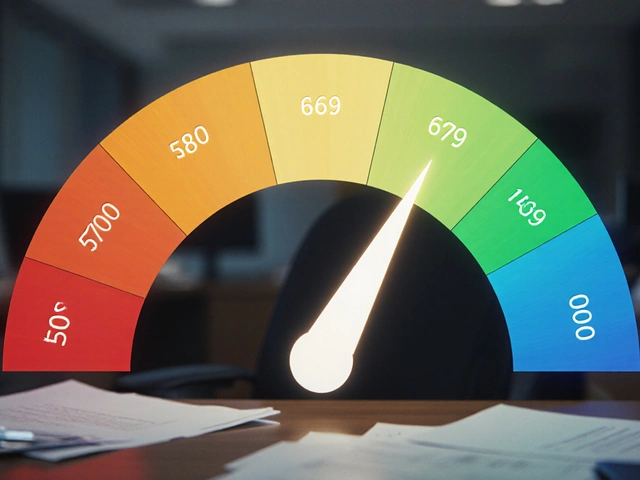
So, you've found yourself wondering just how much an 8 lakh EMI per month could be, right? Well, you're not alone! Figuring out home loan EMIs can feel like cracking a complex code. But don't worry; it's simpler than it seems once you know what goes into it.
First things first, let’s break down that strange-sounding term, ‘EMI.’ It stands for Equated Monthly Installment, which is just a fancy way of saying ‘your monthly loan payment.’ This payment depends on a few key things: the loan amount, the interest rate, and the loan tenure (that's the length of time you agree to pay back the loan).
Interest rates are kind of a big deal. They can make or break your monthly budget because they decide the cost of borrowing that 8 lakh. Higher rates mean higher EMIs, simple as that. And hey, even a small change in the rate can significantly shake things up, especially over the long term.
- Decoding the EMI Formula
- Why Interest Rates Matter
- Factors Influencing Your EMI
- Early Repayment: Is It Worth It?
- Tips to Manage Your EMI Better
- Real-Life Scenarios: What to Expect
Decoding the EMI Formula
Alright, buckle up because we're about to dig into the nuts and bolts of how 8 lakh EMI is calculated. It's easier than it looks, I promise! The heart of the EMI calculation is a formula that uses the principal loan amount, the interest rate, and the tenure of the loan. Let's break this down.
The EMI formula is: EMI = [P x R x (1+R)^N] / [(1+R)^N-1], where:
- P stands for the principal loan amount. In this case, that's your 8 lakh.
- R is the monthly interest rate. You'll take your annual interest rate and divide it by 12, then convert it into a decimal.
- N is the loan tenure in months. If your loan is for 20 years, N becomes 240 (20x12).
With this formula, you can plug in different numbers and see how changes affect your EMI. For example, increasing the loan tenure may decrease the monthly EMI, but might cause you to pay more interest over time.
Let’s put this into perspective. Suppose you have an interest rate of 7% per annum. You'd convert that to 0.00583 for monthly use. Plug those numbers in and you'll see what fits your budget. But remember, if calculations aren't your thing (no judgment), there are online loan calculators that make this process a breeze.
| Loan Tenure (Years) | Monthly EMI (Approx.) |
|---|---|
| 10 | Rs 9,307 |
| 15 | Rs 7,189 |
| 20 | Rs 6,226 |
Whether you're number-savvy or not, understanding these basics can really help you make smarter decisions about your home loan. If you ever feel stuck, reach out to your bank—a good loan officer can be a lifesaver!
Why Interest Rates Matter
When you're dealing with an 8 lakh EMI, the interest rate is one of those things you really need to keep a close eye on. But why does it matter so much? Well, to put it simply, it determines how much extra you’ll pay over the life of your loan. Think of it like the seasoning on a dish – too much and it can really ruin the flavor of your financial plans!
Imagine getting a home loan with a lower interest rate. It means you'll be paying less interest over time, which makes your monthly payments a little friendlier. In contrast, a higher rate can make those same payments swell up, pinching your budget and maybe even stretching your finances thin.
"Understanding how interest rates impact your loan can save you a lot of money in the long run," says Sarah Thompson, a financial advisor from MoneySmart. "Even half a percent lower rate can make a big difference over thirty years."
So, how do these rates actually affect your home loan EMI? Well, if the interest rate is 7% instead of 8%, here's an idea of what that might look like over a 20-year period:
| Interest Rate | EMI (approx.) |
|---|---|
| 7% | 6,219 INR |
| 8% | 6,687 INR |
See that jump? That’s a clear picture of why even small changes can have a big impact. That’s why it’s super important to shop around and compare rates before locking in a loan.
- Use an EMI calculator to see how different interest rates affect your monthly payments.
- Negotiate with lenders wherever possible to get the best deal.
- Keep an eye on market trends; rates can change and impact your future financial commitments.
In the world of home loan EMIs, the rate isn't just a number—it's a key player in your financial story.
Factors Influencing Your EMI
When it comes to understanding how your 8 lakh EMI shapes up each month, it’s all about knowing what goes into the mix. There are several factors at play, and the good news is they’re not as mysterious as they seem.
First, the most obvious player is the loan amount, which in our chat is 8 lakh. Naturally, the greater the loan, the higher the monthly EMI. But wait, there’s more to it. It’s not just about the money you borrow but also how you’re charged for borrowing it, which brings us to the next big factor.
The interest rate takes center stage here. Banks and lenders set these rates based on several criteria like market conditions and your credit score. A lower rate means a happier wallet since it directly reduces the cost of borrowing. On the flip side, high-interest rates can make those EMIs feel like a heavyweight champ sitting on your chest.
| Loan Amount (Lakh) | Interest Rate (%) | Tenure (Years) | EMI (INR) |
|---|---|---|---|
| 8 | 7.5 | 15 | 7,419 |
| 8 | 8.5 | 15 | 7,732 |
Another key component is the loan tenure, or how long you have to repay. Longer tenure means smaller EMIs but remember, this also means paying interest for more years, which can add up. It’s a bit of a balancing act, deciding whether you want to pay more now with higher EMIs or stretch it out over time.
Lastly, don't overlook the processing fees and other charges. These can sneak up on you and slightly tweak your EMI higher than anticipated. It’s crucial to read the fine print or have a chit-chat with your lender to make sure there are no surprises lurking around the corner.
Keeping these factors in mind, you can better forecast and manage what you’ll be shelling out each month as your home loan EMI. Whether you’re planning a new purchase or revisiting your current loan, knowing these elements can help you make a more informed decision.

Early Repayment: Is It Worth It?
Ever thought about jumping ahead on your loan payments? Paying off your 8 lakh EMI sooner might sound appealing, but is it the right move for you? Let's figure it out together.
One perk of early repayment is that you can save big on interest payments. The faster you pay off your loan, the less interest piles up over time. Sounds awesome, right? But hang on, there are some things to consider.
Before jumping the gun, check if your lender charges a prepayment penalty. No one wants surprise fees, especially when you're just trying to light up your financial future. Some banks might charge a percentage of the outstanding loan amount if you wrap up the loan early.
Also, think about your current financial situation. If you have extra cash lying around, it might be tempting to just throw it at the mortgage. But what about an emergency fund or your kid's education? Make sure early repayment won't leave you pinching pennies later on.
Now, suppose your lender doesn't penalize early payments. In that case, consider if the interest saved is greater than the returns you could get from investing that extra sum elsewhere. A smart move could be to use a partial prepayment strategy. Instead of dumping all in one go, make extra payments now and then, reducing the principal quicker without a hefty upfront commitment.
Think you need a visual? Here's a little hypothetical example on how this can pan out:
| Remaining Tenure (Years) | Interest Paid with Regular EMI (INR) | Interest Paid with Early Repayment (INR) | Savings (INR) |
|---|---|---|---|
| 5 | 85,000 | 65,000 | 20,000 |
| 10 | 1,75,000 | 1,35,000 | 40,000 |
These savings sure look sweet, but as always, weigh up the pros and cons before making moves. Remember, taking the time to run the numbers can save or earn you thousands in the long run!
Tips to Manage Your EMI Better
Swinging those EMIs into your favor lies in the little tweaks you can make in your financial journey. Think of them like sneakily adjusting the sails to get smoother sailing. Here are some solid tactics:
- Budget Wisely: Setting aside the EMI amount at the start of the month is a smart move. Treat it like a non-negotiable expense, just like groceries. This way, you won't scramble for cash when the payment is due.
- Emergency Fund to the Rescue: There's peace in knowing you've got a financial cushion. Aim to save enough to cover at least three months' worth of EMIs. It's a lifesaver when unexpected expenses pop up.
- Automate Payments: Setting up automatic transfers can save you from those dreaded late fees. Plus, it's one less thing to remember each month, right?
- Keep an Eye on Interest Rates: Staying in the loop with interest rate changes in the market can be a game-changer. If rates drop, consider refinancing. A lower rate means lower monthly payments.
- Extra Payments When Possible: Got a bonus? Consider throwing some of it into your loan. Extra repayments go straight to the principal, trimming both the loan term and total interest paid.
- Review and Adjust: Life changes, and sometimes your loan plan should too. Reassess your finance status annually and adjust accordingly, whether it’s extending the tenure for ease or ramping up payments to finish early.
Managing your 8 lakh EMI doesn't have to be a juggling act. Implementing these steps can ease the pressure and give you more control over your financial future.
Real-Life Scenarios: What to Expect
Ever wonder how your 8 lakh EMI would play out in real life? Let’s paint a picture by looking at a few practical examples. This way, you can figure out what suits your wallet without any unpleasant surprises.
Imagine you’ve got an 8 lakh loan with an interest rate of 8% and a 20-year tenure. In this case, your monthly EMI would hover around INR 6,691. This rate might shift a bit depending on your bank or any changes in the economy. Always good to keep an ear to the ground for such things!
Now, let's say you’re quicker on your feet with the repayment, opting for a 10-year plan instead. This bumps the EMI up to about INR 9,727. See how the tenure tweaks the numbers? Faster payback means less interest in the long run, but a bigger monthly chunk.
Home loan EMI adjustments can happen if there’s a change in interest rates. For example, a 0.5% hike might seem small, but it could increase your EMI to INR 6,837 on a 20-year plan, slowly piling up extra costs.
Here’s a snapshot of how EMIs change with different interest rates:
| Interest Rate | EMI for 20 Years |
|---|---|
| 7% | INR 6,232 |
| 8% | INR 6,691 |
| 9% | INR 7,161 |
It's easy to think an 8 lakh EMI is just about the numbers, but considering your lifestyle is crucial. Got a job with a steady paycheck? You might handle higher EMIs. But if your income fluctuates, a longer repayment with lower EMIs might be less stressful.
Always check if the bank allows partial prepayments without penalties. This can dramatically reduce your interest burden if you suddenly score a bonus or some unexpected windfall.
In the end, it’s all about understanding the big picture and planning smartly. This way, when you grab the keys to your dream home, your finances are as ready as you are.








Write a comment